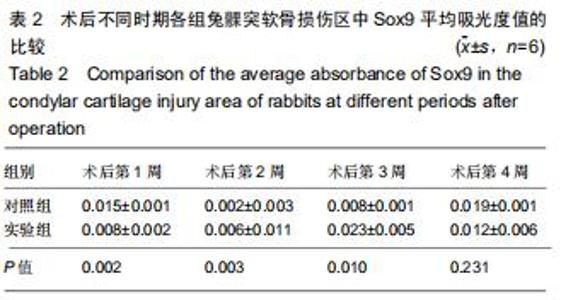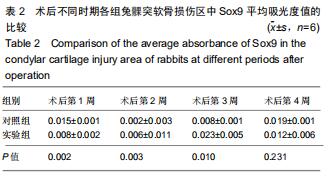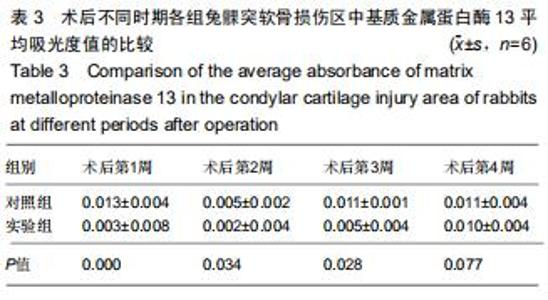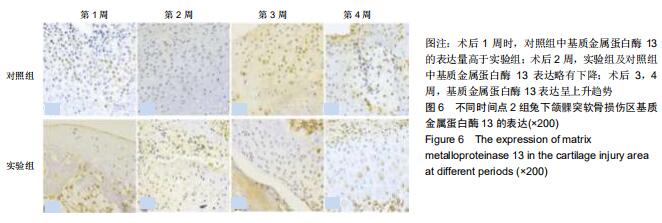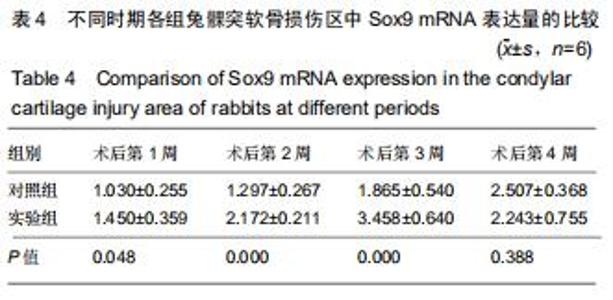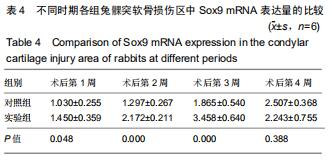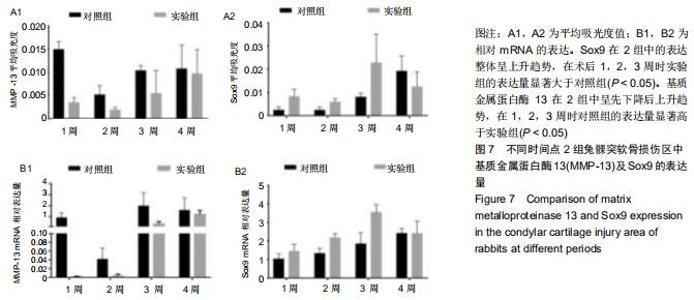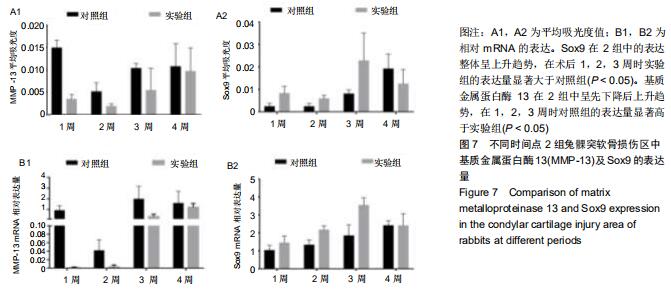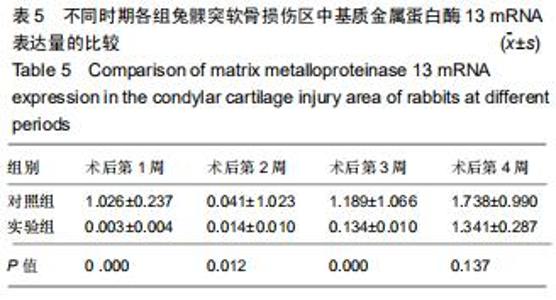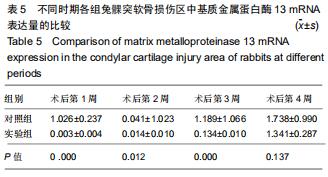Chinese Journal of Tissue Engineering Research ›› 2020, Vol. 24 ›› Issue (32): 5114-5121.doi: 10.3969/j.issn.2095-4344.2858
Previous Articles Next Articles
Effect of parathyroid hormone on cartilage healing in a rabbit model of mandibular condylar fracture
Xie Liuqin, Huang Zhicai, Wang Guangsu, Zhang Guoxing, Li-Du Chenhui, Li Xiao, Tang Zhenglong
- Stomatological Hospital of Guizhou Medical University, Guiyang 550004, Guizhou Province, China
-
Received:2019-11-22Revised:2019-11-29Accepted:2020-01-04Online:2020-11-18Published:2020-09-24 -
Contact:Tang Zhenglong, PhD, Professor, Chief physician, Stomatological Hospital of Guizhou Medical University, Guiyang 550004, Guizhou Province, China -
About author:Xie Liuqin, Master candidate, Stomatological Hospital of Guizhou Medical University, Guiyang 550004, Guizhou Province, China -
Supported by:the Science and Technology Foundation of Guizhou Province, No. [2017]1151
CLC Number:
Cite this article
Xie Liuqin, Huang Zhicai, Wang Guangsu, Zhang Guoxing, Li-Du Chenhui, Li Xiao, Tang Zhenglong. Effect of parathyroid hormone on cartilage healing in a rabbit model of mandibular condylar fracture[J]. Chinese Journal of Tissue Engineering Research, 2020, 24(32): 5114-5121.
share this article

术后1周时,番红O-固绿染色软骨缺损区内见淡绿色组织充填,增殖层和成熟层细胞厚度变薄;苏木精-伊红染色可见软骨损伤区及下方的骨折区有炎性细胞浸润,周围软骨基质发生降解,软骨细胞形态不规则;术后2周时,番红O-固绿染色软骨骨折区见绿色纤维组织充填,其间少量红色软骨基质,实验组较对照组多;苏木精-伊红染色软骨损伤区见大量红色纤维组织,其间见有软骨细胞和少量炎性细胞;术后3,4周时,番红O-固绿染色及苏木精-伊红染色见各层软骨细胞及软骨基质继续沉积在软骨骨折区,炎性细胞逐渐减少,实验组软骨层组织结构较清晰;成熟层及肥大细胞层增厚;对照组软骨基质和软骨细胞较少,在靠近软骨下骨处,见有小血管形成(图3,4)。 "


术后1周时,番红O-固绿染色软骨缺损区内见淡绿色组织充填,增殖层和成熟层细胞厚度变薄;苏木精-伊红染色可见软骨损伤区及下方的骨折区有炎性细胞浸润,周围软骨基质发生降解,软骨细胞形态不规则;术后2周时,番红O-固绿染色软骨骨折区见绿色纤维组织充填,其间少量红色软骨基质,实验组较对照组多;苏木精-伊红染色软骨损伤区见大量红色纤维组织,其间见有软骨细胞和少量炎性细胞;术后3,4周时,番红O-固绿染色及苏木精-伊红染色见各层软骨细胞及软骨基质继续沉积在软骨骨折区,炎性细胞逐渐减少,实验组软骨层组织结构较清晰;成熟层及肥大细胞层增厚;对照组软骨基质和软骨细胞较少,在靠近软骨下骨处,见有小血管形成(图3,4)。 "

|
[1] RASTOGI S, SHARMA S, KUMAR S, et al. Fracture of mandibular condyle—to open or not to open: an attempt to settle the controversy. Oral Surg Oral Med Oral Pathol Oral Radiol. 2015;119(6):608-613.
[2] SHIJU M, RASTOGI S, GUPTA P, et al. Fractures of the mandibular condyle--Open versus closed--A treatment dilemma. J Craniomaxillofac Surg. 2015;43(4):448-451.
[3] HE D , CAI Y , YANG C . Analysis of Temporomandibular Joint Ankylosis Caused by Condylar Fracture in Adults.J Oral Maxillofac Surg. 2014;72(4):763.e1-9.
[4] 王霄,张益,李江明. 髁突矢状骨折继发颞下颌关节强直动物模型的建立[J].北京大学学报(医学版),2011,43(6):125-129.
[5] DAI J, OUYANG N, ZHU X, et al. Injured condylar cartilage leads to traumatic temporomandibular joint ankylosis. J Craniomaxillofac Surg. 2016;44(3):294-300.
[6] 陈锦富,耿倚云,王大平.定向诱导间充质干细胞成软骨分化相关活性因子研究进展[J].组织工程与重建外科杂志,2018,14(4): 227-230.
[7] 王直兵,张峡,张瑗,等.软骨形成因子及骨生成因子在骨重塑中的作用[J].重庆医学,2016,45(27):3865-3867.
[8] 安宁,李耀,唐正龙,等. 不同剂量甲状旁腺激素对下颌支截骨术后骨愈合的影响其机制研究[J].中华口腔医学杂志,2018,53(6): 413-418.
[9] FAN Y, HANAI J I, LE P T, et al. Parathyroid Hormone Directs Bone Marrow Mesenchymal Cell Fate. Cell Metabolism. 2017; 25(3):661-672.
[10] MANSJUR KQ, KURODA S, IZAWA T, et al. The Effectiveness of Human Parathyroid Hormone and Low-Intensity Pulsed Ultrasound on the Fracture Healing in Osteoporotic Bones.Ann Biomed Eng. 2016;44(8):2480-2488.
[11] WANG HL, LIU H, SHEN J, et al. Removal of the articular fibrous layers with discectomy leads to temporomandibular joint ankylosis.Oral Surg Oral Med Oral Pathol Oral Radiol. 2019;127(5):372-380.
[12] BOFFANO P, BENECH R, GALLESIO C,et al. Current opinions on surgical treatment of fractures of the condylar head. Craniomaxillofac Trauma Reconstr. 2014;7(2):92-100.
[13] CHOI KY, YANG JD, CHUNG HY,et al. Current Concepts in the Mandibular Condyle Fracture Management Part II: Open Reduction Versus Closed Reduction. Arch Plast Surg. 2012; 39(4):301-308.
[14] XIANG GL, LONG X, DENG MH, et al. A retrospective study of temporomandibular joint ankylosis secondary to surgical treatment of mandibular condylar fractures. Br J Oral Maxillofac Surg. 2014;52(3):270-274.
[15] ANYANECHI CE. Temporomandibular joint ankylosis caused by condylar fractures: a retrospective analysis of cases at an urban teaching hospital in Nigeria. Int J Oral Maxillofac Surg. 2015;44(8):1027-1033.
[16] WANG X, ZHANG Y, LI JM. Experimental establishment of animal model of temporomandibular joint ankylosis secondary to condylar sagittal fracture.Beijing Da Xue Xue Bao Yi Xue Ban. 2011;43(6):903-907.
[17] ZHANG Y, KUMAGAI K, SAITO T. Effect of parathyroid hormone on early chondrogenic differentiation from mesenchymal stem cells.J Orthop Surg Res. 2014;9:68.
[18] O' BRIEN MH, DUTRA EH, LIMA A, et al. PTH [1–34] induced differentiation and mineralization of mandibular condylar cartilage.Sci Rep. 2017;7(1):3226.
[19] NAKAZAWA T, NAKAJIMA A, SHIOMI K, et al. Effects of low-dose, intermittent treatment with recombinant human parathyroid hormone (1–34) on chondrogenesis in a model of experimental fracture healing. Bone (New York).2005;37(5): 711-719.
[20] 田野,徐莹,付勤.甲状旁腺素促进小鼠软骨细胞成软骨和抑制其终末期分化的实验研究[J].中国组织化学与细胞化学杂志,2013, 22(5):63-67.
[21] AKIYAMA HARUHIKO. Control of chondrogenesis by the transcription factor Sox9. Modern Rheumatology.2008; 18(3): 213-219.
[22] CAO L, YANG F, LIU G, et al. The promotion of cartilage defect repair using adenovirus mediated Sox9 gene transfer of rabbit bone marrow mesenchymal stem cells. Biomaterials. 2011; 32(16): 3910-3920.
[23] 房鹏,赵建宁,张雷.关节软骨细胞外基质代谢中Sox9的调控作用[J].中国组织工程研究,2019,23(22):3570-3576.
[24] 陈臻浩,赵广雷,石晶晟,等.Sox9对软骨细胞分化和基质产生的调控机制[J].复旦学报(医学版),2019,46(6):824-828. [25] LI XL, ZHANG J, LUO HN, et al. Characterization of Sox9-overexpressing human umbilical cord blood-derived mesenchymal stem cells-based engineered cartilage both in vitro and in vivo.J Biomed Mater Res A. 2017;105(4): 1150-1155.
[26] DY P, WANG W, BHATTARAM P, et al. Sox9 Directs Hypertrophic Maturation and Blocks Osteoblast Differentiation of Growth Plate Chondrocytes.Dev Cell. 2012;22(3):597-609.
[27] YAMASHITA S, ANDOH M, UENO-KUDOH H, et al. Sox9 directly promotes Bapx1 gene expression to repress Runx2 in chondrocytes. Exp Cell Res. 2009;315(13):2231-2240.
[28] 陈少坚,郭风劲. Sox9基因促软骨形成作用机制研究进展[J].国际骨科学杂志, 2010, 31(2):65-67.
[29] HASEGAWA S, KITOH H, OHKAWARA B, et al. Tranilast stimulates endochondral ossification by upregulating Sox9 and RUNX2 promoters.Biochem Biophys Res Commun. 2016;470(2):356-361.
[30] BAE JW, TAKAHASHI I, SASANO Y, et al. Age-related changes in gene expression patterns of matrix metalloproteinases and their collagenous substrates in mandibular condylar cartilage in rats.J Anat. 2003;203(2): 235-241.
[31] PAPATHANASIOU I, MICHALITSIS S, HANTES ME, et al. Molecular changes indicative of cartilage degeneration and osteoarthritis development in patients with anterior cruciate ligament injury.BMC Musculoskelet Disord. 2016;17:21.
[32] LI H, WANG D, YUAN Y, et al. New insights on the MMP-13 regulatory network in the pathogenesis of early osteoarthritis. Arthritis Res Ther. 2017;19(1):248.
[33] DENG Z, LUO W, GAO S, et al. The morphology and histology study on rabbit degenerated medial meniscus after posterior cruciate ligament rupture.Biosci Rep. 2019;39(1). pii: BSR20181843.
[34] ZHAN QP, GUI X, WANG F, et al. Sialoglycoprotein isolated from the eggs of Gadus morhua enhances fracture healing in osteoporotic mice.Food Funct. 2017;8(3):1094-1104.
[35] 陈小燕,唐正龙.甲状旁腺激素在颅颌面骨再生研究中的应用进展[J].中华口腔医学杂志,2016,51(6):379-382
[36] DUTRA EH, O'BRIEN MH, CHEN PJ, et al. Intermittent Parathyroid Hormone [1-34] Augments Chondrogenesis of the Mandibular Condylar Cartilage of the Temporomandibular Joint.Cartilage. 2019:1947603519833146.
[37] LUGO L, VILLALVILLA A, GÓMEZ R, et al. Effects of PTH [1-34] on synoviopathy in an experimental model of osteoarthritis preceded by osteoporosis. Osteoarthritis Cartilage. 2012;20(12):1619-1630. [38] MOHANAKRISHNAN V, BALASUBRAMANIAN A, MAHALINGAM G, et al. Parathyroid hormone-induced down-regulation of miR-532-5p for matrix metalloproteinase-13 expression in rat osteoblasts.J Cell Biochem. 2018;119(7):6181-6193. |
| [1] | Hu Kai, Qiao Xiaohong, Zhang Yonghong, Wang Dong, Qin Sihe. Treatment of displaced intra-articular calcaneal fractures with cannulated screws and plates: a meta-analysis of 15 randomized controlled trials [J]. Chinese Journal of Tissue Engineering Research, 2021, 25(9): 1465-1470. |
| [2] | Huang Dengcheng, Wang Zhike, Cao Xuewei. Comparison of the short-term efficacy of extracorporeal shock wave therapy for middle-aged and elderly knee osteoarthritis: a meta-analysis [J]. Chinese Journal of Tissue Engineering Research, 2021, 25(9): 1471-1476. |
| [3] | Xu Feng, Kang Hui, Wei Tanjun, Xi Jintao. Biomechanical analysis of different fixation methods of pedicle screws for thoracolumbar fracture [J]. Chinese Journal of Tissue Engineering Research, 2021, 25(9): 1313-1317. |
| [4] | Jiang Yong, Luo Yi, Ding Yongli, Zhou Yong, Min Li, Tang Fan, Zhang Wenli, Duan Hong, Tu Chongqi. Von Mises stress on the influence of pelvic stability by precise sacral resection and clinical validation [J]. Chinese Journal of Tissue Engineering Research, 2021, 25(9): 1318-1323. |
| [5] | Zhang Tongtong, Wang Zhonghua, Wen Jie, Song Yuxin, Liu Lin. Application of three-dimensional printing model in surgical resection and reconstruction of cervical tumor [J]. Chinese Journal of Tissue Engineering Research, 2021, 25(9): 1335-1339. |
| [6] | Zhang Yu, Tian Shaoqi, Zeng Guobo, Hu Chuan. Risk factors for myocardial infarction following primary total joint arthroplasty [J]. Chinese Journal of Tissue Engineering Research, 2021, 25(9): 1340-1345. |
| [7] | Wei Wei, Li Jian, Huang Linhai, Lan Mindong, Lu Xianwei, Huang Shaodong. Factors affecting fall fear in the first movement of elderly patients after total knee or hip arthroplasty [J]. Chinese Journal of Tissue Engineering Research, 2021, 25(9): 1351-1355. |
| [8] | Wang Jinjun, Deng Zengfa, Liu Kang, He Zhiyong, Yu Xinping, Liang Jianji, Li Chen, Guo Zhouyang. Hemostatic effect and safety of intravenous drip of tranexamic acid combined with topical application of cocktail containing tranexamic acid in total knee arthroplasty [J]. Chinese Journal of Tissue Engineering Research, 2021, 25(9): 1356-1361. |
| [9] | Xiao Guoqing, Liu Xuanze, Yan Yuhao, Zhong Xihong. Influencing factors of knee flexion limitation after total knee arthroplasty with posterior stabilized prostheses [J]. Chinese Journal of Tissue Engineering Research, 2021, 25(9): 1362-1367. |
| [10] | Huang Zexiao, Yang Mei, Lin Shiwei, He Heyu. Correlation between the level of serum n-3 polyunsaturated fatty acids and quadriceps weakness in the early stage after total knee arthroplasty [J]. Chinese Journal of Tissue Engineering Research, 2021, 25(9): 1375-1380. |
| [11] | Zhang Chong, Liu Zhiang, Yao Shuaihui, Gao Junsheng, Jiang Yan, Zhang Lu. Safety and effectiveness of topical application of tranexamic acid to reduce drainage of elderly femoral neck fractures after total hip arthroplasty [J]. Chinese Journal of Tissue Engineering Research, 2021, 25(9): 1381-1386. |
| [12] | Wang Haiying, Lü Bing, Li Hui, Wang Shunyi. Posterior lumbar interbody fusion for degenerative lumbar spondylolisthesis: prediction of functional prognosis of patients based on spinopelvic parameters [J]. Chinese Journal of Tissue Engineering Research, 2021, 25(9): 1393-1397. |
| [13] | Lü Zhen, Bai Jinzhu. A prospective study on the application of staged lumbar motion chain rehabilitation based on McKenzie’s technique after lumbar percutaneous transforaminal endoscopic discectomy [J]. Chinese Journal of Tissue Engineering Research, 2021, 25(9): 1398-1403. |
| [14] | Chen Xinmin, Li Wenbiao, Xiong Kaikai, Xiong Xiaoyan, Zheng Liqin, Li Musheng, Zheng Yongze, Lin Ziling. Type A3.3 femoral intertrochanteric fracture with augmented proximal femoral nail anti-rotation in the elderly: finite element analysis of the optimal amount of bone cement [J]. Chinese Journal of Tissue Engineering Research, 2021, 25(9): 1404-1409. |
| [15] | Du Xiupeng, Yang Zhaohui. Effect of degree of initial deformity of impacted femoral neck fractures under 65 years of age on femoral neck shortening [J]. Chinese Journal of Tissue Engineering Research, 2021, 25(9): 1410-1416. |
| Viewed | ||||||
|
Full text |
|
|||||
|
Abstract |
|
|||||




